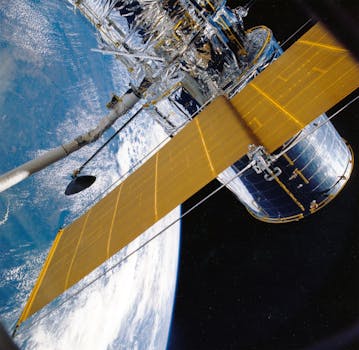
2023 in Review: Major Milestones in Satellite Telecommunications Technology

2023 was a significant year for satellite telecommunications technology, with several major milestones achieved in the field. Satellite telecommunications technology refers to the use of satellites to transmit and receive data, voice, and video signals. This technology has revolutionized the way we communicate, enabling global connectivity and facilitating the exchange of information across the globe.
Satellite telecommunications technology has come a long way since its inception, with significant advancements in recent years. One of the major milestones in 2023 was the launch of new satellite constellations, which are groups of satellites working together to provide global coverage. These constellations have enabled the provision of high-speed internet services, even in remote and underserved areas.
Another significant milestone was the integration of 5G technology with satellite telecommunications. 5G is the fifth generation of wireless technology, offering faster data speeds, lower latency, and greater connectivity. The integration of 5G with satellite telecommunications has enabled the provision of high-speed internet services, even in areas where traditional fiber optic cables are not available.
In addition to these technological advancements, 2023 also saw a growing focus on sustainable practices in the satellite telecommunications industry. With the increasing number of satellites in orbit, there is a growing concern about the environmental impact of satellite technology. As a result, companies are now prioritizing sustainable practices, such as the use of eco-friendly materials, reducing energy consumption, and implementing responsible disposal practices for retired satellites.
The growth of the satellite telecommunications industry has also led to an increase in the number of players in the market. New companies have emerged, offering innovative solutions and services, while established companies have expanded their offerings to meet the growing demand for satellite-based services.
The impact of satellite telecommunications technology on various industries has been significant. For instance, the use of satellite technology has enabled the provision of high-speed internet services in the maritime industry, facilitating communication and navigation for ships at sea. In the aviation industry, satellite technology has enabled the provision of in-flight connectivity, allowing passengers to stay connected during flights.
In conclusion, 2023 was a significant year for satellite telecommunications technology, with major milestones achieved in the field. The launch of new satellite constellations, the integration of 5G technology, and the growing focus on sustainable practices are just a few examples of the advancements made in the industry. As the demand for satellite-based services continues to grow, it is likely that we will see even more innovations and advancements in the field in the coming years.
Advancements in Satellite Constellations

One of the major milestones in 2023 was the launch of new satellite constellations. These constellations are groups of satellites working together to provide global coverage. The launch of these constellations has enabled the provision of high-speed internet services, even in remote and underserved areas.
The advantages of satellite constellations are numerous. For one, they provide global coverage, enabling communication and connectivity even in areas where traditional fiber optic cables are not available. They also offer high-speed internet services, with some constellations offering speeds of up to 1 Gbps.
In addition to these advantages, satellite constellations are also more resistant to natural disasters and other disruptions. Because they are in orbit, they are not affected by earthquakes, hurricanes, or other natural disasters that can disrupt traditional communication systems.
However, there are also challenges associated with satellite constellations. One of the major challenges is the risk of collisions between satellites. With the increasing number of satellites in orbit, there is a growing risk of collisions, which can result in significant damage and disruption to communication systems.
To mitigate this risk, companies are now prioritizing sustainable practices, such as the use of eco-friendly materials, reducing energy consumption, and implementing responsible disposal practices for retired satellites.
Integration of 5G Technology

Another significant milestone in 2023 was the integration of 5G technology with satellite telecommunications. 5G is the fifth generation of wireless technology, offering faster data speeds, lower latency, and greater connectivity. The integration of 5G with satellite telecommunications has enabled the provision of high-speed internet services, even in areas where traditional fiber optic cables are not available.
The advantages of 5G technology are numerous. For one, it offers faster data speeds, with some networks offering speeds of up to 20 Gbps. It also offers lower latency, with some networks offering latency as low as 1 ms.
In addition to these advantages, 5G technology also offers greater connectivity, enabling the connection of a large number of devices to the internet. This has significant implications for industries such as healthcare, finance, and education, where the connection of devices is critical.
However, there are also challenges associated with the integration of 5G technology with satellite telecommunications. One of the major challenges is the need for significant investment in infrastructure. The deployment of 5G networks requires significant investment in infrastructure, including the installation of new cell towers and the upgrade of existing infrastructure.
Another challenge is the need for standardization. The integration of 5G technology with satellite telecommunications requires standardization, to ensure that devices and networks are compatible.
Conclusion

In conclusion, 2023 was a significant year for satellite telecommunications technology, with major milestones achieved in the field. The launch of new satellite constellations, the integration of 5G technology, and the growing focus on sustainable practices are just a few examples of the advancements made in the industry. As the demand for satellite-based services continues to grow, it is likely that we will see even more innovations and advancements in the field in the coming years.
The impact of satellite telecommunications technology on various industries has been significant, and it is likely that this impact will continue to grow in the coming years. With the increasing number of satellites in orbit, and the growing demand for satellite-based services, it is likely that we will see significant investment in the industry, and significant advancements in the field.
However, there are also challenges associated with the growth of the industry, including the need for significant investment in infrastructure, and the need for standardization. To mitigate these challenges, companies must prioritize sustainable practices, and invest in research and development to ensure that the industry continues to grow and evolve.
See more:





